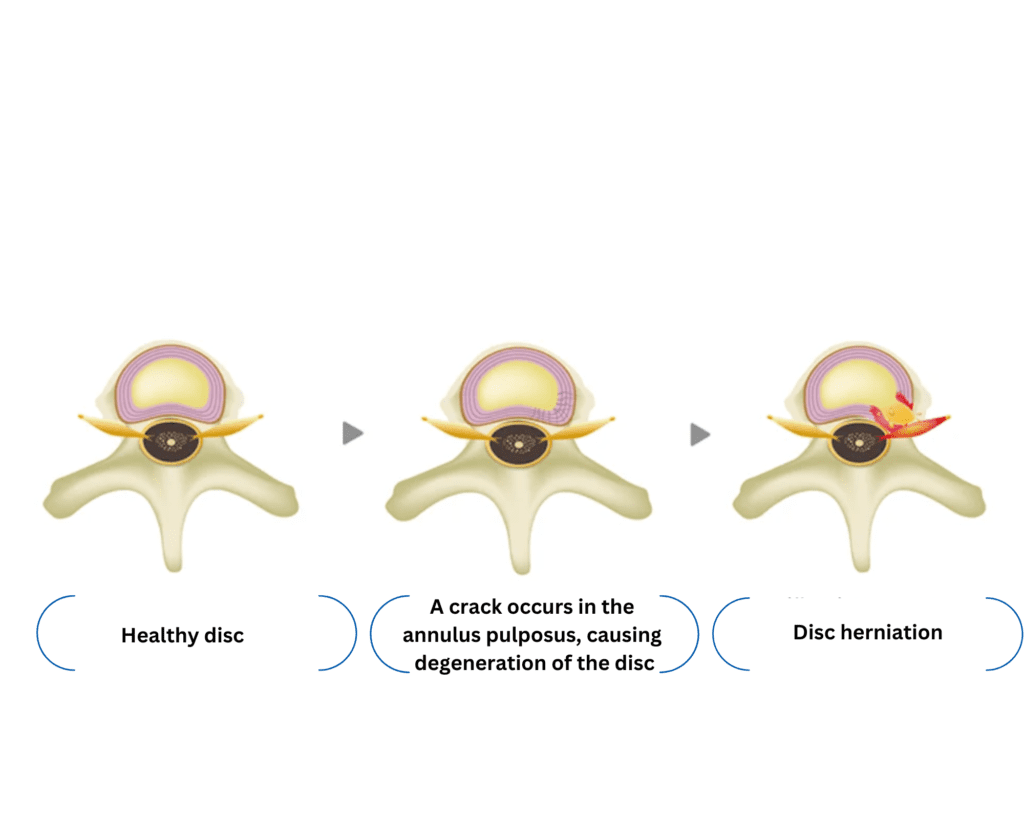07 June 2024
Disc Herniation is said to be the most common spinal condition in the world.
In the past, treatment has been provided through conservative therapy and surgical operations, but in recent years, various advanced medical treatments have become available.
In this article, we will explain about advanced medical care available for herniated discs.
What is disc herniation?
The intervertebral disc is made up of a nucleus pulposus inside and an annulus fibrosus that surrounds it.
Due to genetic factors such as aging or the strain of everyday life, cracks form in the annulus fibrosus, causing the nucleus pulposus to protrude and damage the intervertebral disc. This condition is known as disc herniation.
In the case of lumbar disc herniation, symptoms such as lower back pain, pain and numbness in the buttocks and legs may occur. If the nerves are compressed too strongly, symptoms such as difficulty in urinating or passing stool and even incontinence may occur.

Advanced medical treatments for herniated discs
In recent years, various treatments have been developed for herniated discs.
Advanced medical care is defined as treatment that uses cutting-edge technology. Currently, there are few medical institutions that offer advanced medical care, and most of it are out-of-pocket treatments that are not covered by insurance.
Percutaneous laser discectomy (PLDD)
This is the most widely known treatment for herniated discs. However, it is not suitable for all cases of herniated discs.
A needle is inserted into the herniated disc from the back under local anesthesia, and a laser fiber is passed along the path of the inserted needle. The nucleus pulposus inside the disc is then burned with a laser, creating a cavity in the nucleus pulposus and causing the disc to shrink. The procedure is quick and does not require hospitalization.

Percutaneous ozone discectomy (PODD)
This is a less invasive treatment than PLDD, and there is no risk of complications such as discitis, which is rare occurrence caused by the heat of the laser.
A needle is inserted into the herniated disc from the back of the body under local anesthesia, and a mixture of ozone and oxygen is injected through the tip of the needle, reducing the volume of the herniated disc and relieving pressure on the nerves.
In principle, the treatment is a same-day procedure, but depending on the medical institution, multiple treatments may be required.

Hybrid Laser Treatment
Hybrid laser therapy combines the benefits of PLDD and PODD. It is more effective than PLDD and PODD on their own because it can treat herniation and inflammation at the same time.
Using local anesthesia, the herniated disc is contracted using a laser, and ozone is injected to suppress the radiculitis.

Intradiscal Enzyme Injection Therapy (Hernicore)
This is a treatment that is relatively new.
Intradiscal enzyme injection therapy involves injecting a drug containing enzymes into the intervertebral disc, which changes the composition of the disc and causes the hernia to disappear. Usually, a hospital stay of 1 to 2 days is required.
Intradiscal enzyme injection therapy can only be performed once in a lifetime and cannot be repeated.

Disc regeneration therapy: PRP therapy, stem cell therapy
Recently, PRP therapy and stem cell therapy have been receiving a lot of attention, as these two therapies aim to repair the intervertebral disc.
In PRP therapy, PRP (platelet-rich plasma) that has been collected in advance is injected into the annulus fibrosus of the intervertebral disc under local anesthesia to allow the cracks to repair naturally.
In the same way, in stem cell therapy, stem cells are collected in advance and then cultured before being injected into the intervertebral disc under local anesthesia. This repairs the intervertebral disc and relieves pain.
The treatment itself (injection into the disc) can be done as a day procedure, but blood sampling is required a few days before the scheduled treatment date, so at least two hospital visits are necessary.

The Cellgel Method
Although surgical procedures can reduce pain and numbness, they do not repair the cracks in the disc, so there is a risk of the herniated disc recurring.
At our hospital, we perform the Cellgel method, a treatment that can actually repair the intervertebral disc, which is not possible with other treatments.
It is one of the most advanced treatment methods that has been researched and developed in recent years, and is backed by solid evidence.
It is a curative treatment because the drug injected into the damaged disc fills the cracks and forms a gel-like substance to repair the cracks. The volume of the disc is not reduced, and the drug remains in the disc as a gel-like implant after treatment, so the disc is preserved.

In addition, unlike other treatment methods, it is possible to check whether the disc has been repaired using CT or X-rays after treatment.

The Cellgel method does not require hospitalization and can be done as a day procedure. It can be used for a wide range of conditions caused by disc damage, not just herniated discs, and can also be used for people who have not been able to get rid of their pain after surgery, or who have had a recurrence, even if they are over 80 years old.
Advanced medical treatments for herniated discs: a summary
| Cellgel Method | Hernicore | PLDD | PODD | Hybrid Laser Therapy | PRP Therapy | Stem Cell Therapy | |
| Interverte -bral disc repair | 〇 | × | × | × | × | 〇 | 〇 |
| Preservation of the interverte -bral discs | 〇 | 〇 | △ | △ | △ | 〇 | 〇 |
| Anesthesia | Local anesthesia | Local anesthesia | Local anesthesia | Local anesthesia | Local anesthesia | Local anesthesia | Local anesthesia |
| Length of Treatment | about 15mn | about 10mn | about 15mn | about 15mn | about 25mn | about 30mn | about 60mn |
| Incision | 1mm or less | 1mm or less | 1mm or less | 1mm or less | 1mm or less | 1mm or less | 1mm or less |
| Length of hospitalization | one-day treatment | 1 to 2 days | one-day treatment | one-day treatment | one-day treatment | one-day treatment (but blood sampling and treatment will require 2 separate visits to the hospital) | one-day treatment (but blood sampling and treatment will require 2 separate visits to the hospital) |
| Insurance coverage | Out-of-pocket treatment | Covered by insurance | Out-of-pocket treatment | Out-of-pocket treatment | Out-of-pocket treatment | Out-of-pocket treatment | Out-of-pocket treatment |
| Return to normal life | The next day | After discharge | The next day | The next day | The next day | The next day | The next day |
| Recurrence | None | Possible | Possible | Possible | Possible | Possible | Possible |
About the author of this article

Orthopedic surgeon: Dr. Tadaaki Minowa
Professional Associations and Qualifications:
Japanese Society for the Study of Low Back Pain
Japanese Society for Endoscopic Surgery
Certified Occupational practitioner for the Japan Medical Association
Japan Cancer Treatment Certification Organization, Certified Cancer Treatment practitioner
Certified practitioner for the Cellgel method
Ozone Therapy Certified Physician
Certified practitioner for the Florence method



